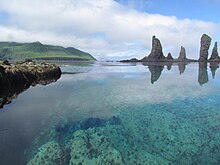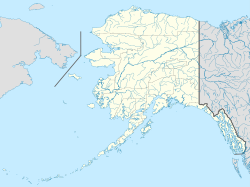Kagamil Island (Aleut: Qagaamila;[1] Russian: Кагамил), in the Islands of Four Mountains subgroup of the Aleutian archipelago, is 3.7 miles (6.0 km) north of Chuginadak Island and 1.2 miles (1.9 km) south of Uliaga Island. It is 6.2 miles (10.0 km) in length and up to 3.1 miles (5.0 km) in width. The southern half of the island is dominated by the Kagamil Volcano, which has two summits: one is 2,930 feet (890 m) above sea level, while the other is lower at 2,260 feet (690 m).

Henry Wood Elliott discovered a cave on the island containing 13 native mummies.[2] Over 50 bodies were recovered by Aleš Hrdlička from 1936 to 1938.[3]
History and geography
editKagamil Island is one of the four mountains of the Aleutian Archipelago. It is located on the Western tip of Alaska, bordering the Bering Sea.[4] This island was given the Unangam Tunuu name by Captain Tebenov in 1852 when he discovered the island. Kagamil had also received various names by other Russian explorers. Two major volcanoes are located toward the southern tip of this island. One crater is above sea level, while the other one is below sea level.[4] As of 1929, the activity of these two volcanos is unknown, but during that year, some volcanic activity was detected underground these two natural structures. Surrounding these summits are multiple sites of hot springs. The average temperature of this region is approximately nine degrees celsius, and it is home to plenty of wildlife. But today, these islands have no human populations living on them, however, there has been evidence that a pre-Aleutian civilization existed. In fact, this island has a rich prehistoric history. This evidence has been well-preserved due to the lack of erosion and wildlife disturbances. Kagamil Island is an area of numerous cave systems. Archaeologists have created many excavation sites, and they found that these caves hide multiple mummies. Although similar to the mummies found in Egypt, there are many differences that these cave mummies have compared to the ones found in Egypt. Several studies have been conducted on these specimens, and they reveal much about the prehistoric society. In addition, hair and feather fragments have also been analyzed from the mummies.
Early tool use
editRecently, two skeletons have been discovered in these caves along with many tools. These skeletons were found among volcanic ash remains. Archaeologists have conducted radiocarbon dating of the specimens, and they found that these date back to approximately 3000 BC when the last volcanic eruption occurred in the area. Among these tools, they found that a great portion were made from bird bones.[5] With these bones, it appears that they stitched together fragments to create blad-like structures, which suggests that these early people lived in a hunter-gatherer society. In addition to bone tools, this early society seemed to use stone tools as well. At the time when the volcanoes were active, the most abundant rock was obsidian. Archaeologists have found many obsidian flakes as well as obsidian cores. They used these obsidian flakes to build various tools.[5] Although their tools suggest that they may have lived a hunter-gatherer life, archaeologists have also found remains of permanent dwellings among the volcanic ash. These dwellings appear to be purposed for permanent dwellings as there have been multiple living units discovered in the spaces. In fact, in some excavation sites, archaeologists have found up to 300 individual houses. Within these houses, works of pottery and netting were found.[6] This raises the point that these people have developed the skill of fishing to provide for their community.
Feather samples among the mummies
editFeather samples among the mummies have also been closely analyzed. Scientists and archaeologists working on the Kagamil island have cooperated to try and identify these species from which these feathers came from. Researchers used microscopic evidence to find the exact family, genus, and species of these bird species to obtain insight of the past environment of the Kagamil islands. They use microscopic details because these bird feathers have microscopic features such as barbs that help with this identification.[7] In addition, these specimens from the excavation site reveal that pre-Aleutian society not only used the feathers, but they also used bird skin for many purposes.
Subpopulations of early Kagamil Island inhabitants
editUsing isotopic data to analyze the bone structures, scientists have discovered that the island had two different groups of inhabitants that used to live on this piece of land: the paleo-Aleut and the Neo-Aleut. Studies suggest that the Paleo population existed approximately 1000 years ago, and were later replaced by the Neo population.[8]
Diets and lifestyle
editIsotopic analysis from three excavation sites were analyzed, and the researchers found that the paleo and neo population differed greatly in their diet, likely due to the changes in environment over time. Their bone chemistries suggest that the neo population diet had higher trophic level food, such as meat and fish, than the paleo populations, therefore, their bones had a smaller N15 to N14 ratio. Consistent with this finding is the discovery of the size and shape of their skeletons’ craniums. The paleo population appeared to have more docile post-cranials while the neo population had a rounder and wider cranium.[8] Because the cranial capacity of the neo population was larger, it suggests that the neo population had higher tool-making and decision-making abilities. With their more advanced tools, the neo population were able to gain access to higher trophic-level food compared to their paleo-counterparts. Hence, they were able to use obsidian tools and netting.[6]
References
edit- ^ Bergsland, K. (1994). Aleut Dictionary. Fairbanks: Alaska Native Language Center.
- ^ "A Tribe of Indians with Queer Speech Discovered in Alaska. FINDING OF THEIR MUMMIES". Sioux City Journal. April 5, 1896. p. 6. Retrieved 19 July 2019 – via Newspapers.com.
- ^ Aufderheide, Arthur C. (2003). The Scientific Study of Mummies. Cambridge University Press. ISBN 978-0-521-81826-1.
- ^ a b "Global Volcanism Program | Kagamil". Smithsonian Institution | Global Volcanism Program. Retrieved 2024-04-21.
- ^ a b "Current Research". American Antiquity. 35 (2): 239–277. 1970. ISSN 0002-7316.
- ^ a b Hrdlicka, Ales. "The Aleutian and Commander islands and their inhabitants". Wistar Institute of Anatomy and Biology.
- ^ Dove, Carla. "MICROSCOPIC ANALYSIS OF FEATHER AND HAIR FRAGMENTS ASSOCIATED WITH HUMAN MUMMIFIED REMAINS FROM KAGAMIL ISLAND, ALASKA" (PDF). repository.si.edu.
- ^ a b Byers, David A.; Yesner, David R.; Broughton, Jack M.; Coltrain, Joan Brenner (2011-01-01). "Stable isotope chemistry, population histories and Late Prehistoric subsistence change in the Aleutian Islands". Journal of Archaeological Science. 38 (1): 183–196. doi:10.1016/j.jas.2010.09.005. ISSN 0305-4403.
External links
edit- Aleutian Islands - Kagamil Island at the Wayback Machine (archived December 23, 2010)
- picture of Kagamil Island
